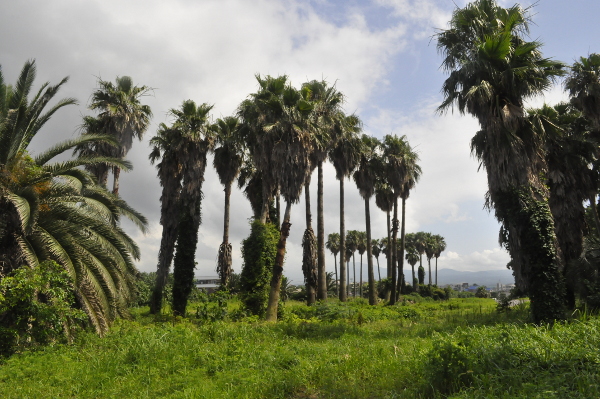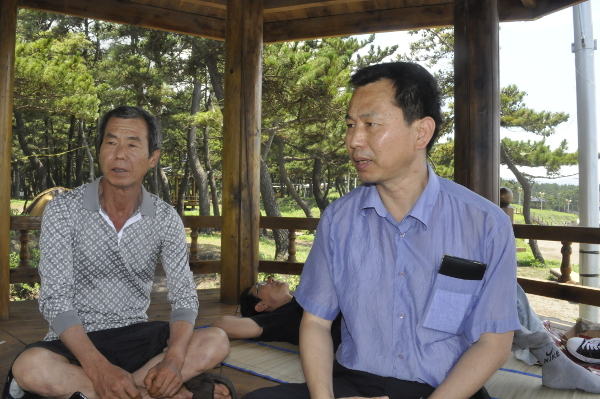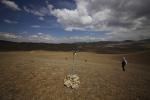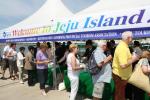
- Updated 2024.11.13 16:25
- All Articles
-
member
icon
-
facebook
cursor
-
twitter
cursor
| |
 |
|
| ▲ Photo by The Jeju Weekly |
The palm tree is almost as iconic to Jeju as the tangerine. And like the tangerine, the palm is foreign to these here lands.
When I first heard this, that the palm is not indigenous to the island, I had to know its story.
And after (surprisingly) months of searching, following up dead ends and false leads, The Jeju Weekly found it. Jeju’s first palm tree.
A stone’s throw from Iho Tewoo Beach in Jeju City, there is an abandoned field with a single horse tethered to a post, and a cluster of palm trees at its northern end.
Our guides, brothers Lee Yong Seok and Lee Jong Seok, walked The Weekly through the thick brush to the trees.
“So, let me see,” said Yong Seok pointing at two, tall though worn and sickly looking Washington palms, “... These palm trees have been growing for 60 years.”
These are the first palms in Jeju, planted in 1953.
......
The Weekly’s search for the elusive first palm started when outfront of Ripley’s Believe or Not! in Jungmun, Seogwipo City, I noticed two large palm trees with placards out front.
One of the placards read: “The Columbus Palm Tree — The First Palm Tree In Jeju.” Under the title it said the tree was the first palm in Korea, planted in 1980 to test the island’s feasibility of having palm trees.
I went to speak with the Ripley's manager to verify. She said she had no way of authenticating the claim, and that she had no idea where the notion came from. I told her I’d figure it out and let her know.
| |
 |
|
| ▲ Lee Jong Seok points out a special palm. Photo by The Jeju Weekly |
The Weekly then called government offices thinking that the palms were a tourism initiative in line with branding the island, “The Hawaii of Korea.” No one contacted seemed to know anything about the palms. Eventually someone at the Korea Tourism Organization (KTO) said that the project to palm Jungmun was a central government initiative and executed by the now defunct Jeju Tourism Development Organization.
The KTO then got us in touch with their Horticultural Manager Yang Seok Gyun.
In an email interview he said, “We don’t know the specific year [it was decided to plant palm trees in Jeju],” though a farmer by the name of Lee Jeong Jun introduced the island to the palm tree in the 1970s.
We called the Sumok farm, and though Lee Jeong Jun is now deceased, his sons Yong Seok and Jong Seok agreed to meet with me.
“In 1953 my father read a newspaper story,” said Yong Seok, from a gazebo overlooking Iho Beach, about a Korean sailor who travelled to Singapore. There, he saw palm trees, collected some seeds from underneath, and came home to plant them, in Seoul.
He succeeded, and the first 20 palm trees in Korea were grown in his house, not on Jeju, but on the mainland.
“My father bought the 20 palm trees from the sailor,” said Yong Seok, two of which sit abandoned in the field near Iho that they showed The Weekly.
The trees were a variety known as the Washington palm tree and grow taller than other varieties, able to survive typhoons, and grow rapidly. To this day, the majority of the palm trees in Jeju are Washington palms.
Then a young man, just out of high school in Japan, Jeong Jun was interested in exotic and Western agriculture, and pursued his interest with a scientific mind.
“When he started the business, people were very skeptical,” said Yong Seok. “Some even called my father a ‘mad man.’ As you know, palm trees are not edible. People thought it as totally useless.”
And, for a time, the family was not well off, said the brothers. For money the family also grew Western crops and exotic flowers like celery and lettuce.
But to the criticism he received from his peers, “My father answered that [palm trees] will be needed someday when Korea becomes developed,” said Yong Seok.
| |
 |
|
| ▲ Brothers Lee Jong Seok and Lee Yong Seok. Photo by The Jeju Weekly |
And Jeong Jun was right, to the point of almost being prescient.
During the 1960s the local government came knocking. They wanted palm trees planted out front of Gwendeokjeong, the old city hall of Jeju. After that, the government bought trees to line certain streets to give Jeju the aura of an exotic city, said Yong Seok.
“At that time, only a few people went abroad and could see palm trees,” said KTO’s Yang Seok Gyun. “And they have an exotic look, so it became a symbol of overseas trips.”
“Between the 1960s to 1970s, there were a lot of agencies [hotels and resorts] asking to plant [palm] trees to make an exotic atmosphere,” said Jung Seok, adding “With that money we bought land. We made a lot of money.”
In 1980, executing a project initiated by the then recently deposed President Park Chung Hee to transform Jungmun into a tourism complex, the Jeju Tourism Development Corporation bought hundreds from Sumok Farm at 10 million won a trunk.
Though neither the brothers or Yang Seok Gyun were able to quantify in tourist dollars the value of the trees, they both agreed that it was substantial.
“Visitors can feel the exoctic atmospere in the Jungmun Tourist Resort. The exotic and unique atmosphere helps increase the number of visitors … Thanks to the palm trees, Jungmun became a representative tourist attraction. And palm trees are a good source of income for plam tree nurserymen,” said Yang Seok Gyun.
Though it is impossible to know exactly how many palm trees there are in Jeju, the Jeju provincial Department of Forest and Environment said that there are 3,209 of them lining the streets of Jeju.
“Now other regions in Korea are buying palm trees from Jeju,” said Yong Seok Gyun.
And though Jeong Jun passed away four years ago at the age of 84, his impact on the character of Jeju and on the island’s image, has been greater than most anyone else. And with few understanding his contribution to Jeju, the brothers both said he had great pride in his work.
......
As we sat there in the gazebo overlooking the beach, I asked them if they knew of the trees outside Ripley’s and their claim of being the first in Jeju. They said they didn’t, though the trees most probably were grown on their farm.
I asked if this falsehood bothered them.
“Whether that is the first palm tree or not does not matter,” said Yung Seok. “The spirit ingrained in the palm trees is what is important. See, it contains the dreams and hopes of the one who planted it.”
I then asked if they had heard of the myth associated with them, that if two lovers placed their thumbs against the palm tree their love would last forever.
“No, I’ve never heard about it,” said Yong Seok. “But it’s fun for people. I think that it is okay. That is also one part of the storytelling marketing strategy which can attract tons of people. For example, in Jeju there is a myth that if you touch the nose of the Dolharubang three times then your wish will be fulfilled. Lots of tourists believe what it, but that story was faked by taxi drivers.”
Jong Seok added, “I also think if people pay more attention to the palm trees and get interested in palm trees because of that story that is good, and that is helpful for us too.” |
|
|
|
|
|
|
|
ⓒ Jeju Weekly 2009 (http://www.jejuweekly.net)
All materials on this site are protected under the Korean Copyright Law and may not be reproduced, distributed, transmitted, displayed, published without the prior consent of Jeju Weekly. |
|
|
|
|
| Jeju-Asia's No.1 for Cruise |
|
|
|
Title:The jeju Weekly(제주위클리) | Mail to editor@jejuweekly.net | Phone: +82-64-724-7776 Fax: +82-64-724-7796
#503, 36-1, Seogwang-ro, Jeju-si, Jeju-do, Korea, 63148
Registration Number: Jeju, Ah01158(제주,아01158) | Date of Registration: November 10,2022 | Publisher&Editor : Hee Tak Ko | Youth policy: Hee Tak Ko
Copyright ⓒ 2009 All materials on this site are protected under the Korean Copyright Law and may not be reproduced, distributed, transmitted, displayed, published
without the prior consent of jeju weekly.com.

|






















